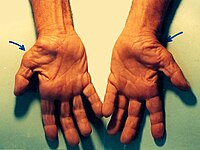
Photo from wikipedia
Introduction Tissue acquisition from subepithelial lesions is most often attempted by EUS-guided fine needle aspiration/biopsy as conventional endoscopic biopsy usually fails to reach the lesion in deeper layers of the… Click to show full abstract
Introduction Tissue acquisition from subepithelial lesions is most often attempted by EUS-guided fine needle aspiration/biopsy as conventional endoscopic biopsy usually fails to reach the lesion in deeper layers of the gastrointestinal wall. Tunnelled biopsy, a ‘bite-on-bite’ biopsy technique that penetrates the covering mucosa by repeated biopsies, enables access to tumours below the mucosa. We investigated the utilisation, safety and diagnostic yield of an intensified tunnel biopsy protocol. Methods The endoscopy reporting database was searched for patients with reported subepithelial lesions in the upper gastrointestinal tract from March 2013 to September 2017. The tunnel biopsy protocol was defined as bite-on-bite technique from the identical spot creating a submucosal tunnel, taking at least 10 passes of double biopsies with a standard biopsy forceps, while targeting the subepithelial lesion. Patient records were reviewed for histology reports, imaging studies, adverse events and readmissions after endoscopy. Results 152 patients (70 M, 82 F) were found to have at least one subepithelial lesion at upper endoscopy with a median lesion size of 12 mm (interquartile range 9–25 mm). Superficial conventional biopsies were taken in 79 patients and were diagnostic only for one lipoma (1.3%). Tunnel biopsies were taken in 71/152 patients (47.4%). Sites were oesophagus (9), stomach (58) and duodenum (4). Tunnel biopsies were diagnostic in 31/71 (43.6%), revealing 9 leiomyomas, 1 leiomyosarcoma, 7 lipomas, 2 pancreatic rests, 10 GISTs, 1 retention cysts and 1 fibrotic nodule. For lesions≥20 mm the diagnostic yield of tunnel biopsies further increased to 16/28 (57.0%). There was no major immediate adverse event or 30 day readmission related to delayed complications from the procedure. Only two of the 36 endoscopists involved in this study routinely performed tunnel biopsies from subepithelial lesions. Attempting tissue acquisition via tunnel biopsy was significantly more likely to achieve diagnostic histology than by superficial biopsies (p<0.00001). Conclusions Tunnel biopsy is a simple, safe and reasonably efficient diagnostic modality for tissue acquisition in subepithelial lesions in the upper gastrointestinal tract. This technique is still underutilised and should be routinely attempted if a subepithelial lesion is detected at the index endoscopy.
Journal Title: Gut
Year Published: 2018
Link to full text (if available)
Share on Social Media: Sign Up to like & get
recommendations!